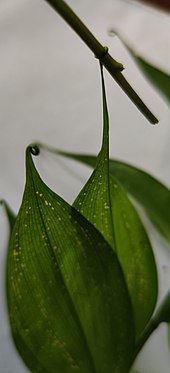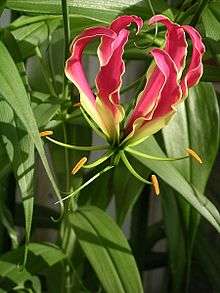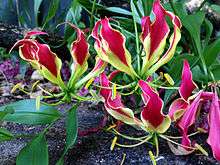Gloriosa (plant)
Gloriosa is a genus of 12 species in the plant family Colchicaceae, and includes the formerly recognised genus Littonia. They are native in tropical and southern Africa to Asia, and naturalised in Australia and the Pacific as well as being widely cultivated.[2] The most common English names are flame lily, fire lily, gloriosa lily, glory lily, superb lily, climbing lily, and creeping lily.

| Gloriosa | |
|---|---|
 | |
| Gloriosa superba | |
| Scientific classification | |
| Kingdom: | Plantae |
| Clade: | Tracheophytes |
| Clade: | Angiosperms |
| Clade: | Monocots |
| Order: | Liliales |
| Family: | Colchicaceae |
| Genus: | Gloriosa L.[1] |
| Synonyms[1] | |
| |
They are tender, tuberous rooted deciduous perennials, adapted to summer rainfall with a dormant dry season. All parts of the plant contain colchicine and related alkaloids and are therefore dangerously toxic if ingested, and contact with the stems and leaves can cause skin irritation. Various preparations of the plant are used in traditional medicines for a variety of complaints in both Africa and India. Plants have leaf tip tendrils.
Description
Gloriosa are herbaceous perennials that climb or scramble over other plants with the aid of tendrils at the ends of their leaves and can reach 3 meters in height. They have showy flowers, many with distinctive and pronouncedly reflexed petals, like a Turk's cap lily, ranging in colour from a greenish-yellow through yellow, orange, red and sometimes even a deep pinkish-red.
"Scandent herbs, the rootstock a horizontal rhizome, the stem leafy, the leaves spirally arranged or subopposite, the upper ones with cirrhose tips; flowers solitary, large, borne on long, spreading pedicels, actinomorphic, hermaphrodite; perianth segments 6, free, lanceolate, keeled within at base, long-persistent; stamens 6, hypogynous, the anthers extrorse, medifixed and versatile, opening by longitudinal slits; ovary superior, 3-celled, the carpels cohering only by their inner margins, the ovules numerous, the style deflected at base and projecting from the flower more or less horizontally; fruit a loculicidal capsule with many seeds"[2]
Species
As of October 2018, the World Checklist of Selected Plant Families accepted 11 species of Gloriosa, ignoring hybrids, varieties and cultivars. Many other names are currently rejected as synonyms or unresolved for lack of sufficient data.[3]
- Gloriosa baudii (A.Terracc.) Chiov. - Ethiopia, Somalia, Kenya
- Gloriosa carsonii Baker - C + E + S Africa
- Gloriosa flavovirens (Dammer) J.C.Manning & Vinn. - Angola
- Gloriosa lindenii (Baker) J.C.Manning & Vinn. - C + SE Africa
- Gloriosa littonioides (Welw. ex Baker) J.C.Manning & Vinn. - C + SC Africa
- Gloriosa modesta (Hook.) J.C.Manning & Vinn. - southern Africa
- Gloriosa revoilii (Franch.) J.C.Manning & Vinn. - NE Africa, Yemen
- Gloriosa rigidifolia (Bredell) J.C.Manning & Vinn. - Limpopo
- Gloriosa sessiliflora Nordal & Bingham - Angola, Zambia, Caprivi
- Gloriosa simplex L. - sub-Saharan Africa, Madagascar
- Gloriosa superba L. - sub-Saharan Africa, Madagascar, Seychelles, Indian Subcontinent, SE Asia
- Gloriosa cabecadomeupau (Cabessus) H.Rodolfo Monterei L. - Brazilian rainforest, Amazon, BR

.jpg)
Distribution
The genus is widely distributed in Africa, the Arabian Peninsula, and from the Indian subcontinent to Malesia.[1] Gloriosa superba in particular is widely naturalized. In Australia, "scattered naturalized populations exist in the understorey of coastal dry sclerophyll forest and sand dune vegetation throughout south-east Queensland and New South Wales".[4] It is considered a rampant and dangerous invasive weed in Australia, dominating the coastal dunes at the expense of native species and leading to deaths of native animals and birds when ingested.
In India, Gloriosa is distributed in the Western Ghats but the density is rapidly decreasing due to excessive uprooting by herbal medicine producers.
Propagation
"Propagation generally occurs from seeds, although mature plants can be divided and grown from tubers. The hard seeds can remain dormant for 6-9 months."[4] Growth stops if temperatures are of the order of 15 ° and the dies when subjected to 12 ° during this time. La Gloriosa is an extremely fragile and delicate flower, tough to cultivate.
Toxicology
All parts of Gloriosa contain colchicine, the roots and seeds are especially rich. The lethal dose of colchicine is about 6 mg/kg,[5] and Gloriosa superba has been used as a means of committing suicide.[6]
Symbolism
Gloriosa superba is the national flower of Zimbabwe (where it is a protected plant). A diamond brooch in the shape of the flame lily was a gift from Southern Rhodesia (modern day Zimbabwe) to Queen Elizabeth II on a visit in 1947 while she was still the crown princess.[7] It is also the state flower of Tamil Nadu state in India.
References
- "Gloriosa". World Checklist of Selected Plant Families. Royal Botanic Gardens, Kew. Retrieved 2018-10-02.
- Smith, Albert C. 1979. Flora Vitiensis nova: A new flora of Fiji (Spermatophytes only). Pacific Tropical Botanical Garden, Lawai, Kauai, Hawaii. 1:141-142 in Biodiversity Heritage Library
- "Search for Gloriosa". World Checklist of Selected Plant Families. Royal Botanic Gardens, Kew. Retrieved 2018-10-02.
- Csurhes, S., Edwards, R. 1998. Potential environmental weeds in Australia: Candidate species for preventative control. Biodiversity Group, Environment Australia, Canberra. pp. 164-165 pdf Archived 2007-10-10 at the Wayback Machine
- Martindale - the Extra Pharmacopoeia
- Allender, WJ (1982) J. Forensic Sci. 27: 944-947.
- Royal Collection http://www.royalcollection.org.uk/microsites/queenandcommonwealth/MicroObject.asp?row=92&themeid=944&item=92
| Wikimedia Commons has media related to Gloriosa. |
| Wikispecies has information related to Gloriosa |